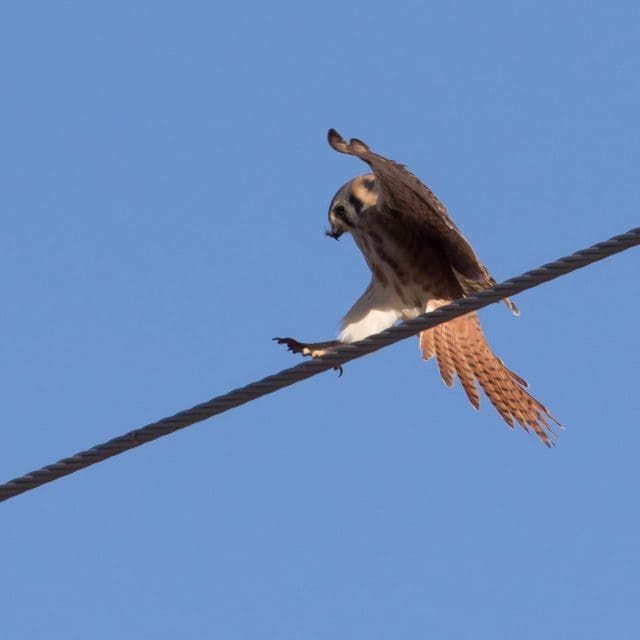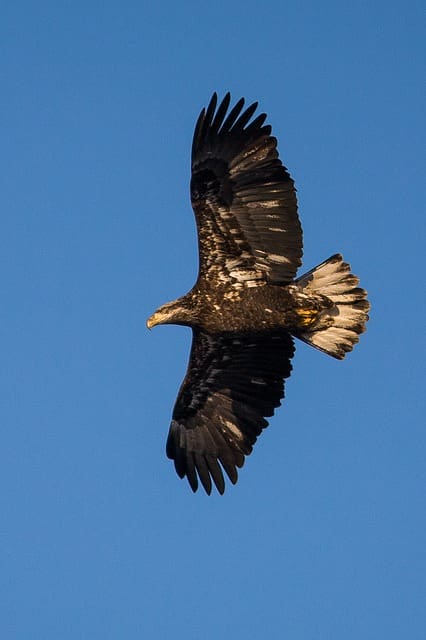My interest in birding around Eagle Mountain and other Cedar Valley areas was sparked by the abundance of wintering raptors I noticed the first time I drove through the area. I’ve always been interested in birds of prey and the Eagle Mountain area provided lots of opportunities to observe, study, and photograph them. The open spaces, nearby mountains, and sagebrush habitat are perfect for eagles, hawks, and falcons. They are also great therapy for people who love to discover the outdoors. I learned very quickly during subsequent birding trips that the area becomes home to different bird species with the changing seasons.Cooper has spent many hours walking the hills around Soldiers Pass, Manning Canyon, Eagle Mountain, Fairfield, Cedar Fort, and Lake Mountain. He has seen a lot of different species of birds. Cooper explains some of his birding tricks, and experiences.
While Golden Eagles hunt the sagebrush expanses year round and nest in the local canyons, it is only during the winter months that Bald Eagles will be seen. Ferruginous Hawks and Prairie Falcons nest in remote areas during the spring and summer breeding seasons, but they are regularly seen around the Eagle Mountain area during the fall and winter months. Rough-legged Hawks and Merlins are regular winter visitors to the area as well. They come to the valley from as far away as Alaska and Northern Canada. Few people have ever seen Burrowing Owls, but I can locate them in the Cedar Valley using my knowledge of their habitat and behaviors. The Juniper Titmouse is a little-known bird that can regularly be found in the juniper habitat in the nearby mountains and canyons. During the spring and summer months we can find relatively rare, northern Utah desert birds such as Northern Mockingbird, Gray Vireo, Black-throated Sparrow, Sagebrush Sparrow, Gray Flycatcher, and Ash-throated Flycatcher along the south end of Lake Mountain and Soldiers Pass. Many Utah Birders look long and hard for Pinyon Jays. We actually see them regularly in places like Manning Canyon and Solders Pass. I also enjoy the mammals and reptiles I encounter while birding the Cedar Valley. With spring at our door we can expect Swainson’s Hawks to return for another breeding season.Eagle Mountain is also the home to a large population of American Kestrels. Last year Eagle Mountain residents and other bird enthusiasts participated in the Eagle Mountain Kestrel Project (EMKP). The project continues this year, as well as their second year with their live webcam. The EMKP has teamed up with HawkWatch International (HWI). HawkWatch International had this to say about the EMKP.
Eagle Mountain is a wonderful example of a community embracing conservation efforts at home and being part of research at a broader scale. It is exactly what we hope for when growing our efforts and partnerships to new areas—local buy-in and ownership. In Eagle Mountain, this starts with tremendous support from Mayor Pengra and the city, a local organizer and driving-force in the form of Shon Reed, and an engaged group of citizen scientists. HawkWatch International is thrilled to have Eagle Mountain as a partner in our Kestrel research efforts and looks forward to future collaboration on this and other raptor studies.
 Here is a summary of the Kestrel nesting boxes found in Eagle Mountain. Values in parentheses are the number of nests in each category. (Data supplied by HWI).
Here is a summary of the Kestrel nesting boxes found in Eagle Mountain. Values in parentheses are the number of nests in each category. (Data supplied by HWI).
 The EMKP has started its second year in Eagle Mountain. A few nest boxes have been added, a couple have been relocated to make way for park improvements and development. Birdwatchers have reported positive signs this year, and the project is confident that they will again see the majority of their boxes being used by Kestrels this year. Last year the EMKP and HWI joined forces and were able to band forty five (45) chicks from nest boxes located in Eagle Mountain. Two birds, male and female from different nests were spotted by their colored leg bands in Syracuse, 70 miles north of Eagle Mountain.
Lydia Ripplinger, also an avid birder and nature photographer, discusses why she likes birding around Lake Mountain and Eagle Mountain.
The EMKP has started its second year in Eagle Mountain. A few nest boxes have been added, a couple have been relocated to make way for park improvements and development. Birdwatchers have reported positive signs this year, and the project is confident that they will again see the majority of their boxes being used by Kestrels this year. Last year the EMKP and HWI joined forces and were able to band forty five (45) chicks from nest boxes located in Eagle Mountain. Two birds, male and female from different nests were spotted by their colored leg bands in Syracuse, 70 miles north of Eagle Mountain.
Lydia Ripplinger, also an avid birder and nature photographer, discusses why she likes birding around Lake Mountain and Eagle Mountain.
Eagle Mountain is an amazing place to watch and photograph birds, especially birds of prey. In Eagle Mountain, you’ll encounter many species of hawks, owls, eagles, and falcons, including a good number of kestrels, the smallest, and in my opinion, most beautiful falcons in North America. Though I don’t live in Eagle Mountain, I find myself visiting the area multiple times a month to observe the raptors and to participate in the growing kestrel conservation project being carried out in the area. Eagle Mountain is a beautiful, unique and valuable place for bird enthusiasts of all types.Lydia has also gone with the EMKP to check boxes and has helped with that community effort.

Additional Resources
Bird Sightings in Eagle Mountain on ebird.com HawkWatch International Jeff Cooper – Neo Vista Birding Lydia Ripplinger – Instagram AccountHawkWatch International Blog Articles
[wp_rss_retriever url=”http://hawkwatch.org/blog?format=feed&type=rss” items=”2″ excerpt=”50″ read_more=”true” new_window=”true” thumbnail=”100″ cache=”7200″]Mike Kieffer is an IT geek by hobby and trade, with a BS in Information Systems & Technology. He is a proud father of 10, a grandpa, an author, a journalist, and internet publisher. His motto is to “Elevate, Inspire and Inform”, and he is politically conservative and a Christian. Mike has a passion for technology, writing, and helping others. With a wealth of experience, he is committed to sharing his knowledge with others to help them reach their full potential. He is known for his jackassery or his form of self-expression that encourages boldness, creativity, and risk-taking. It can be a way to push the boundaries and challenge traditional norms, leading to creative solutions and positive change.
